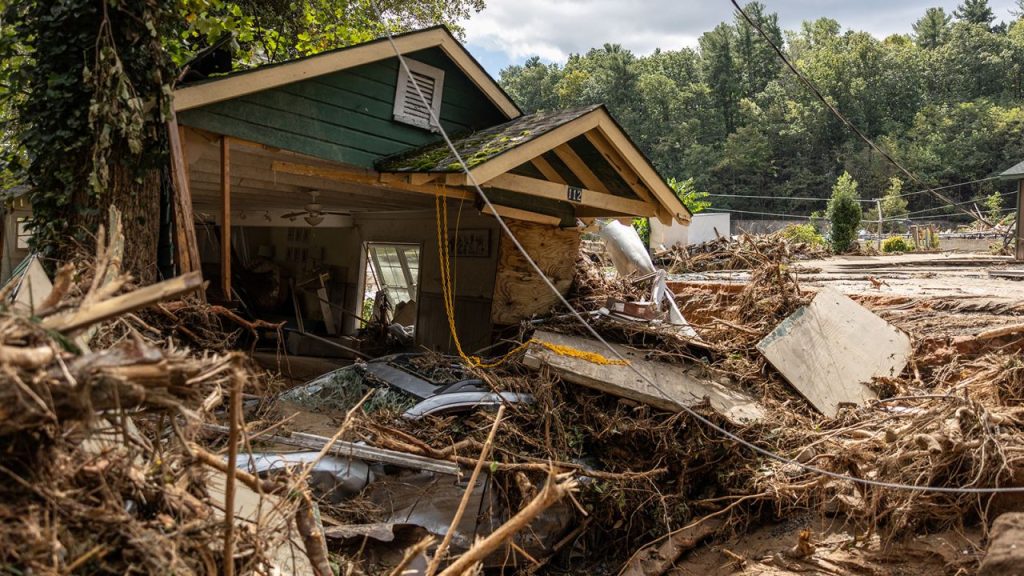As construction sounds echoed through Main Street in Marshall, North Carolina, the historic Madison County Courthouse stood closed, bearing the brunt of Tropical Storm Helene’s fury. Local officials and community leaders gathered to discuss the overwhelming challenges they faced in the wake of the storm, which left significant damage across the region.
Madison County Manager Rodney Honeycutt addressed the dire need for repair funds, stating that the county would require $6.2 million to restore the courthouse — the oldest operating court in the state. This cost would only cover interior repairs, leaving out essential work on the structure itself. “When you have a budget of $32 million and you need to spend $6.2 million on just one building, it’s impossible,” said Honeycutt. The courthouse, built in 1907, has long been an iconic symbol of the county’s history, making the repair efforts even more urgent.
Honeycutt’s remarks were made during a regional tour organized by the American Flood Coalition, a bipartisan nonprofit, to assess the post-storm recovery needs across Western North Carolina. The key takeaway from the discussions was clear — the region is in desperate need of more funding to recover from the devastation left by the storm.
Federal and State Funding Falls Short
The aftermath of Tropical Storm Helene has left many residents and business owners struggling, with the damage running into billions of dollars. State and local lawmakers have been advocating for more financial support, but so far, the response has been insufficient. According to the North Carolina Office of State Budget and Management, the total costs for storm damages and repairs are estimated to be a staggering $59.6 billion. In response, elected officials sought $25.5 billion in federal funding for the region during a visit to Washington, D.C. in November. However, most estimates suggest that the actual funding allocated falls significantly short of the region’s needs.
On January 29, Johnathan Krebs, Governor Josh Stein’s Western North Carolina Recovery Advisor, informed the North Carolina House Select Committee on Helene Recovery that the state was expected to receive only $15.7 billion in federal funding. This amount covers just a fraction of the storm’s total impact. Furthermore, some of the funds remain uncertain, with potential delays due to executive orders from President Donald Trump.
Despite the shortfall, the U.S. Department of Housing and Urban Development (HUD) has allocated at least $1.6 billion in Community Development Block Grants to support recovery efforts. But, as Governor Stein emphasized in early January, this amount is nowhere near sufficient to meet the region’s needs.
“The cost to recover is just overwhelming,” said Canton Mayor Zeb Smathers. “Without federal funding, there’s no way we can recover at this scale.”
Small Towns Like Marshall Are Struggling to Cope
In towns like Marshall, the financial burden of the storm has been overwhelming. Mayor Aaron Haynie explained that the town had already spent $1.3 million on “pump and haul” services to deal with wastewater management after the storm. For a town with an annual budget of around $1.2 million, this was an enormous financial strain.
Marshall, like many other small towns, has faced confusion over where to seek financial help. The town has applied for funds from the Federal Emergency Management Agency (FEMA), but the process has been slow. The uncertainty over whether relief will come from state or federal sources has only added to the frustration.
The storm’s impact on Marshall has been far-reaching. The town is currently without a post office, and key buildings, including the county courthouse and the social services office, have been rendered unusable. Madison County has formally requested $198 million in recovery funds, but with a budget of just $32 million, the county is in dire need of external assistance.
Rebuilding Natural Resources and Infrastructure
Apart from repairing public buildings, the damage to the region’s natural resources has also been significant. Reid Wilson, Secretary of the North Carolina Department of Environmental Quality (NCDEQ), joined the American Flood Coalition’s tour to discuss how the state plans to address environmental damage. The department has been managing debris removal efforts and installing air curtain incinerators to clear out storm debris. Wilson pointed out that a significant portion of the rebuilding efforts would require increased funding and careful planning to restore the region’s natural landscapes.
“The scale of this recovery is massive, and we’re committed to working closely with communities to ensure we rebuild stronger and more resilient than before,” Wilson stated.
Governor Josh Stein has made it clear that the recovery of Western North Carolina is a top priority for his administration. As part of his recovery plan, Stein has pledged to push for additional federal and state funding to support the region’s rebuilding efforts.
Challenges Remain for Local Communities
Despite the progress made, significant challenges remain for local communities. The slow response from FEMA and confusion over where funding will come from has left many small towns like Marshall in limbo. These towns are struggling to repair basic infrastructure, such as water systems and roads, while also dealing with long-term recovery efforts for homes and businesses.
For now, local officials are left waiting for the much-needed aid to flow in. While some federal funds have been allocated, it’s clear that the amount provided so far is not enough to address the overwhelming challenges facing communities across Western North Carolina.
As state and federal authorities work to address the funding gap, local communities are calling for immediate action to ensure they can rebuild and recover from the devastation caused by Tropical Storm Helene.
Disclaimer – Our editorial team has thoroughly fact-checked this article to ensure its accuracy and eliminate any potential misinformation. We are dedicated to upholding the highest standards of integrity in our content.





More Stories
North Carolina Officials Demand More Federal Funding as Recovery from Tropical Storm Helene Faces Major Setbacks
North Carolina Officials Demand More Federal Funding as Recovery from Tropical Storm Helene Faces Major Setbacks
North Carolina Officials Demand More Federal Funding as Recovery from Tropical Storm Helene Faces Major Setbacks